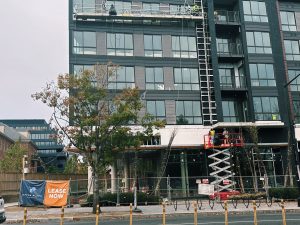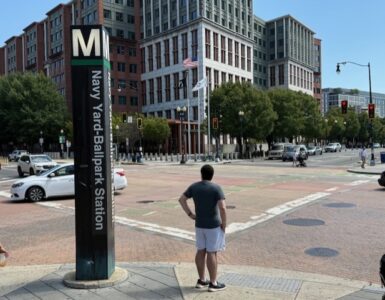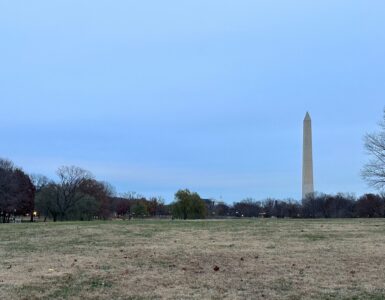Upper Northwest residents are preparing for potential change, as the city continues to work on a proposal for new development on one of the area’s main corridors, Wisconsin Avenue.
The Advisory Neighborhood Commissions 3A and 3E co-hosted a presentation last Thursday from the D.C. Office of Planning about the draft Wisconsin Avenue Development Framework, a set of recommendations highlighting new zoning and housing capacity on the mixed-use corridor.
Erkin Ozberk, a senior neighborhood planner at the Office of Planning, said Wisconsin Avenue is part of the corridors the administration considers an “opportunity-rich” area, as it has amenities such as proximity to the Metro, green areas, and retail spaces.
“This [is] a place that is desirable to live and work at,” Ozberk said. “We want to ensure that a broader range of people are able to live here and experience these amenities.”
The effort is part of the broader Rock Creek West Corridors Planning Initiative, which was released back in 2019 when Mayor Muriel Bowser set the goal of producing 36,000 housing units citywide by 2025.

According to the project’s website, the framework applies to over 100 development sites along a 1.5-mile segment, between Western Avenue and Rodman Street, along Wisconsin Avenue, envisioning equitable, mixed-use development to support the need for housing at various income levels.
Ozberk said residents have been receptive to the recommendations since they recognize there’s a need for housing and development across the region.
“I think people understand the challenges the District is facing in terms of housing and the role the city needs to play to make progressive changes to achieve future goals,” he said.
The framework highlights a highly competitive retail and commercial environment evolving in the District, putting Wisconsin Avenue at a disadvantage in maintaining its position as a retail destination, becoming primarily a neighborhood-serving corridor.
However, the administration also points out that the changing conditions present opportunities for growth in multi-family, residential buildings that can be accomplished through redevelopment.
Thaddeus Bradley-Lewis, the chair of ANC 3A, said residents understand that development needs to occur in Ward 3, recognizing Wisconsin Avenue is one of the corridors where it might happen.
“Most people understand we need development, we need more housing,” Bradley-Lewis said. “In order to attain those goals, they recognize development needs to happen along our corridors.”
Bradley-Lewis has lived in the District for 20 years, moving to McLean Gardens back in 2019. When he moved to the area, he said development was occurring in neighboring Cathedral Heights, with luxury apartments Cathedral Commons opening among retail space.
In McLean Gardens, Bradley-Lewis said similar developments, City Ridge and Upton Place, are being integrated into the community.
“[Cathedral Commons] opened shortly before we moved into the neighborhood. Now, we have these two developments in process,” he said. “They bring a lot of landmass, a lot of housing. Especially for Ward 3.”

During last week’s meeting, neighbors raised concerns about what impact the proposed zoning changes might have on those who currently live in the area. Many wondered what the city would do to ensure school capacity for new and current residents, address potential traffic issues, and ensure that safety in the neighborhood is kept to standards.
Bradley-Lewis said residents understand the city has goals to tackle the issue of housing, but they also want to have confidence the administration is putting the community’s needs first.
“Our residents want to know that this process is being done in a holistic way,” he said. “It’s tough to have a conversation about increasing density without thinking about whether or not the city is doing ample planning of the impacts.”
Back in September, the Historic Preservation Review Board voted to allow its members to consider the Bowser administration’s design guidelines for Connecticut Avenue in Cleveland Park, raising concerns among residents in the area over whether to accept change in the historic district.
Mary Eugenia Perdomo, a new Cathedral Heights resident, said there needs to be an understanding between the Bowser administration and Ward 3 residents to reach realistic goals.
“I think there needs to be a collaborative effort between neighbors and the city,” Perdomo said. “If there isn’t, no one will be able to reach their goals and be happy with any change that might come.”
Perdomo said one thing she enjoys about her new home is the proximity to retail spaces in the area.
“I think it makes a difference to have the ability to walk to the grocery store or to grab a bite at a restaurant,” she said. “I definitely would like to see more of that in this area.”

Jimmy Walter, who has lived in the area for almost five years, said the city’s proposal for Wisconsin Avenue lacks recommendations for what he considers important factors that make a holistic community.
“It’s all about building high-rises and adding retail space,” Walter said. “What about green spaces? Increasing schools’ capacity? Improving the Metro system? Honestly, that’s what I liked to see.”
Bradley-Lewis said he recognizes the city has more work to do for residents to feel less hesitant towards proposed development.
“I hope that the District does a better job in presenting a holistic vision for our ward,” he said. “We’re strategizing ways that will address issues residents have raised, but people are going to have a hard time supporting this pursuit unless they keep hearing from the District.”
Ozberk said the Office of Planning will review and make necessary revisions to the document after the public comment period ends on Nov. 15. The office will release official guidelines for Wisconsin Avenue early next year.















Add comment